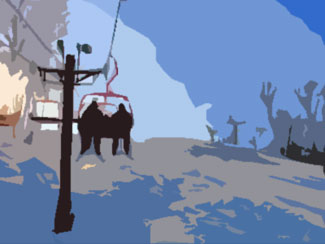Page 1 Page 2

I am cold on this chair and wish I had worn long underwear. To maintain circulation, my fingers are tapping in 6/8 time against my ski poles. Americans don’t understand how cold minus 11 Celsius is. For them, the temperature is 12 Fahrenheit, which sounds considerably warmer. Does snow have an odour? I think I detect a whiff of cedar in the air. A month ago, I rode with two Russian software engineers who spoke excellent English. They understood minus 11 C and wanted to talk about Russian tennis players. They smiled when I asked if they could play chess.
As I gaze down at the Canadian vista I am reminded of a Cornelius Krieghoff or perhaps Lawren Harris painting. I see a large group of snowshoers stalking through the western red cedars; I wonder where they are heading. To an abandoned cabin once used by outlaws? Snowshoers like to have a destination, unlike us downhillers who merely go up and down all day long. Snowshoers tend to recognize animal tracks and trees. They can point out the hemlock’s leader droop, the Englemann spruce and the Lodge Pole Pine.
Snowshoe runners are distant relations of the folk down there. They verge on the extreme side of sports, and all wildlife goes to ground when a band of them are out for a brisk 10 km run on their compact snow shoes. Their shrieks and yells are terrifying as they lunge down trails, prompting snowmobilers to respectfully pull over and avoiding eye contact.
I think I am halfway. What music should be the backdrop? The Chieftains or Prokofiev’s Troika? I spot some cross-country skiers crossing the trail, looking a bit like characters out of the film Reds. Cross-country skiers have an image problem: they’re perceived as a bunch of gawky backpacking environmentalists who can’t afford or don’t have the coordination to downhill ski. Downhillers, on the other hand, have fashion attitudes and maybe $1,000 worth of ski lessons and equipment to their names; many have never seen a cross-country skier up close. Cross-country skiers are often relegated to the eastern side of the resort, where in 2048 there’s going to be a new golf course named after Mary Ann Lapointe. Even the names of cross-country trails are tamer than their downhill counterparts. Cotton Trail, Raven Ramble versus Roller Coaster and Agitator. Snowshoers and cross-country skiers do have something in common. They regard downhillers as SUV baby boomers whose idea of culture is to attend a Rod Stewart or Van Morrison concert. Snowshoers and cross-country skiers prefer Cirque du Soleil.
The boy has his arm around the girl, and they are sitting even closer. I see two red- and black-clad ski instructors leading a group of novice skiers down the hill. It is prestigious being a ski instructor, but it’s a difficult job. Should I sign up for some ski lessons? We are getting increasingly higher, and I don’t want to look down. Each year this height thing gets worse. I looked it up on the Web and found it is called acrophobia. How safe is this chairlift anyway? Did the design engineer pass all his courses? Did he have a bad day due to his Bavarian girlfriend leaving him for an Irish rock star? If it stops in midair, how will I get down? Someone has dropped a pole. How will they ski down the mountain? We must be halfway by now. I felt the chair slow down. I am becoming even colder―
I need a diversion. Are these second-growth trees? What was in this area 100 years ago? Who lived here? Again I wonder, were there once outlaws living here? The history of most ski resorts allocates into periods before some new high-speed quad chair was installed or before the opening of the stupendous hotel owned by two Saudi princes and Bill Gates.
When the visibility is good and there is no wind, I sometimes take another chair up to the summit where balsam fir trees create “snow ghosts” from a combination of snow and the formation of crystals. That chair is a two-seater affair dating back to before the first personal computer, and with the correct wind and loading, it admirably demonstrates simple harmonic motion in two axes.
An icy blast hits my face at the same time a sign appears that says, “prepare to unload,” but I will keep the supporting bar down until the last moment since I am so frightened of heights. The sign now commands me to “keep my tips up.” I see a kiosk where the lift worker is supposed to be stationed. Will he stop the chair if I fall? Perched in high above the kiosk, there is an array of log-periodic antennae together with microwave dishes , all covered heavily in snow. The couple have unloaded and are now kissing. I will go left in order not to hit them, but will the chair slow down enough so I can unload safely?
The sun is shining brilliantly, and I can see the ski resort far below in the valley. In the distance I see ranging hills with some fluffy clouds above, and I think I can make out Lake Okanagan. I adjust my boots and secure my pole straps. I should be able to get two more runs in before lunch, starting with Roller Coaster.
“Hier ist Heinz!”
“ Claire, Café Casa is to the right”
“Anne Marie, let’s do another blue before lunch. Are your boots still hurting?”
I hear some one whistling Alegria from Cirque du Soleil.
Page 1 Page 2
Pages: 1 2

